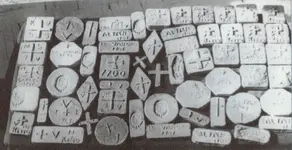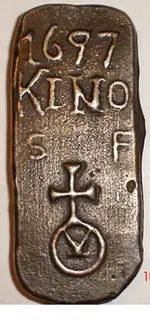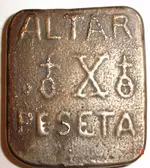Dear group;
Let's take an example of how a theory breaks down when exposed to the light of factual evidence. let's take a single statement and place in under heavy scrutiny for all to see.
"Then there is the case of the missing billions (yes BILLIONS) of pounds of copper, mined in the Great Lakes region during the same time period, by some mysterious people and nowhere to be found in the Americas - yet there is a tremendous supply of copper to make bronze in the Old World during the same time period, when there is no such supply known during their time in the Old World. Coincidence?"
First, how do we KNOW that billions of copper are in fact missing? Did someone inventory the native copper, then when they returned a few years later noticed that a billion pounds of the stuff were missing? I can imagine that the thought process went something like this: "Hmmmm, now where IS all of that native copper that was lying around here

There was a few billion pounds of the stuff that we were going to use to make something special for the chiefs' wedding. I guess I should report this to the front office."
Sure, I'll bet that it happened in just that manner. First, copper is not native to the Great Lakes region, iron is. But, just for the sake of argument, let's assume that there actually was several billion pounds of readly accessible and mineable native copper in the region. Has anyone ever seen what 1 BILLION pounds of copper looks like

I've seen a few tons of it before and that was a LOT of copper. I can just imagine how big of a mountain that one B-I-L-L-I-O-N pounds of native copper looks like. That would a HUGE mountain of copper.
OK, so now we have our 1 billion pounds of copper lying in the ground, just waiting to be mined by some industrialistic natives. To mine 1 billion pounds of native would have taken an EXTRAORDINARY amount of labor. The manpower requirements for exploiting 1 billion pounds of native copper would be mind boggling by todays' standards, to say nothing of the fact that everything had to be extracted from the earth by hand, using only the crudest sort of tools. It would have required hundreds of thousands of men, working round the clock for generations merely to extract 1,000,000 pounds of native copper ore, to say nothing of the processing part.
So where did the miners live while they were mining this ore? You can't mine copper of this magnitude without there being a trace of the people who mined the ore. The process would have required cities of men and women, complete with a supporting logistics system, in order to accomplish an undertaking of this size. Nobody can tell me that the miners homes disappeared from the earth without a trace as something on a scale this large cannot just up and disappear.
So what happened to the ore after it was wrenched from the earth? Was it shipped to Europe or to other points, henceforth unknown? In order to transship 1 billion pounds of processed copper ore, it would have required tens of thousands of ships, each displacing around 50 tons and each sailing back and forth non-stop for generations in order to move the 1 billion pounds of copper ore. Again, you cannot possibly hide the residue from a 10,000 ship fleet, no matter how hard you tried. Surely there would be SOME evidence of this massive fleet, as evidenced by waste, trash, lost items and shipwrecks. It's simply impossible to think about.
Now, this is logical deduction breaking apart the statement that billions of copper were somehow displaced by person, or persons, unknown and has yet to be found. Now we can proceed to further tear apart this rather ridiculous statement through the use of scientific deduction. How can science help us to determine the validity or falseness of the statement in question?
By the simple use of metallurgy, that's how. A good metallurgist, working in a lab, can not only tell from region the ore from a particular metallic artifact was mined at, they can also tell us the approximate age of the artifact, by the particular process which was utilized to smelt and shape the piece. First, the scientist examines the modecular structure of the artifact. This is known as the *lattice* or the matrix. From this lattice the scientist can determine the base metal, the alloying agents used, the trace minerals and the processes used to shape and form the artifact. From all of this data the scientist can pinpoint the region the ore in the artifact came from. From the alloying agents and the modecular spacing of the lattice the scientist can deduce the time frame the artifact was manufactured in and also the region in which the artifact was produced.
I can state with some authority that NO copper or bronze artifact has yet been discovered in either Europe, Asia or Africa which has shown to have been manufactured using ores or alloys mined from the Great Lakes region of the USA. Again, using logic and science together, one can assume that 1 billion of native copper ore would an untold amount of artifacts. The artifacts would be virtually EVERYWHERE. They would be turning up in every spot on the planet. This is how much that 1 billion pounds of copper equals. With one billion pounds of mined native copper ore the planet would have no need to mine any more copper, right up till today. As yet, there has no been even close to one billion pounds of native copper mined on the entire planet.
On the surfacr, such a statement might seem to have some basis of fact, but once examined from all sides and all of the logical questions have been asked, it crumbles into dust. To drive home the point further still, scientific process can be incorporated to completely rip to shreds the statement that billions of pounds of native copper were mined in the Great Lakes region of the USA, then simply disappeared to parts unknown, by persons unknown. It just didn't happen.
Your friend;
LAMAR



 There was a few billion pounds of the stuff that we were going to use to make something special for the chiefs' wedding. I guess I should report this to the front office."
There was a few billion pounds of the stuff that we were going to use to make something special for the chiefs' wedding. I guess I should report this to the front office."










